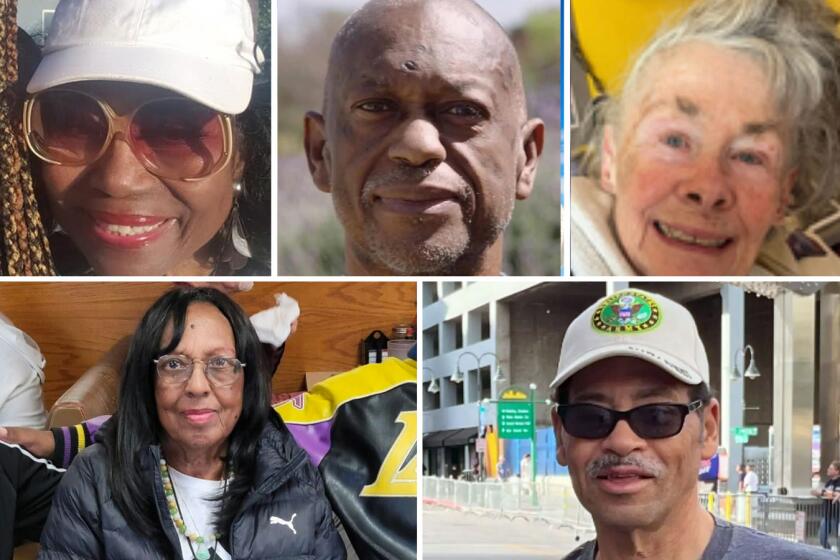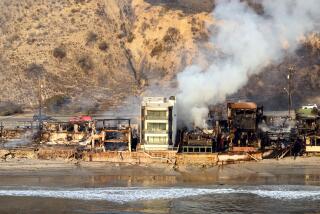
- Share via
- The Palisades and Eaton infernos have destroyed more than 30 structures that preservationists consider historically significant.
- The tally could grow as an accounting continues.
- The fate of many notable properties remains unknown.
Will Rogers’ ranch home. Pasadena Waldorf School. Robert Bridges House. The Bunny Museum. Andrew McNally House. Theatre Palisades. The Zane Grey Estate.
The Palisades and Eaton infernos have laid waste to more than 30 structures considered historic in what preservationists believe is the single worst loss of such properties in the region’s history.
“It’s staggering and heartbreaking — I don’t know any other way to put it,” said Ken Bernstein, principal city planner at Los Angeles City Planning’s Office of Historic Resources. “This is widespread destruction of significant architecture and places that are cherished in our communities.”
The tally could grow, perhaps dramatically, as an accounting of the losses continues. Though institutions including the Getty Villa were saved, the fates of many other notables — such as several influential mid-century Case Study Houses built with Arts & Architecture magazine’s sponsorship — remain unknown.
Remembering lives lost in the Eaton and Palisades fires, the most destructive fires in Los Angeles’ history.
The Los Angeles Conservancy said Friday afternoon that 32 properties it considered historic because of their architectural or cultural significance were consumed by the fires, which have destroyed or damaged more than 9,000 structures.
Some of the historic buildings, including Altadena’s Zane Grey Estate and Rogers’ western-style Palisades home, had formal landmark status on the National Register of Historic Places or another list. But others, such as Fox’s Restaurant in Altadena and Theatre Palisades, were considered important in part because of their status as beloved community spaces.
“It is a mass erasure of heritage,” said Adrian Scott Fine, chief executive of the Conservancy, a nonprofit dedicated to historic preservation. “We haven’t seen anything like this before.”

In some cases, notable properties are severely damaged but not obliterated, including Gladstones, the seaside fish restaurant formerly owned by the late L.A. Mayor Richard Riordan, according to the Santa Monica Mirror. In the Altadena foothills, much of Zorthian Ranch burned, including artwork by founder Jirayr Zorthian. But two buildings of the artists’ colony were spared, said Jason Deach, a ranch hand who visited the site Thursday.
“Every other thing is gone, wiped from the map,” he said.
Some institutions have already vowed to rebuild — among them the Bunny Museum in Altadena, which featured quirky but seemingly irreplaceable collections of porcelain figurines, artwork, clothing and other items depicting rabbits. The Lake Avenue museum lost roughly 46,000 objects.

“We are losing these touchstones — physical places in the world that mark our intellectual history,” said Richard Schave, a preservation advocate and co-founder of Esotouric, a cultural tour service.
As natural disasters grow increasingly intense amid climate change, preservationists said they face a new, and foreboding, challenge. The losses from the week’s fires have highlighted a fundamental shift in the field.
Historic landmarks by the likes of Myron Hunt and Elmer Grey and a noted Midcentury retreat by architect Ray Kappe have been lost. Here’s our residential architecture list, to be updated regularly.
“The quintessential historic preservation threat of the 20th century was symbolized by the bulldozer demolishing individual historic structures or communities for urban renewal,” Bernstein said. “Today, it’s the extreme climate event. Wildfire, sea-level rise and extreme winds pose not incremental threat but constant threat of widespread destruction of our most cherished historical and architectural landmarks.”
Eaton fire obliterates ‘esoteric knowledge’
Some of Altadena’s notable properties, Zorthian Ranch and the Bunny Museum among them, tell the story of the community’s long-standing role as a haven for free spirits, mystics and counterculture figures.
Their destruction, Schave said, amounts to an erasure of regional history tied to “raising social consciousness to effect positive change.” He and his wife, Kim Cooper, the other founder of Esotouric tours, were particularly upset over the loss of the Theosophical Library Center.
The Lake Avenue facility housed the largest collection of materials related to Theosophy, a modern religious movement that counted writers such as William Butler Yeats as devotees and was influential among later New Age belief systems. “That was a repository of esoteric knowledge,” Cooper said.
In the catastrophic Palisades fire, one of the city’s iconic thoroughfares was severely damaged and large swaths of homes were reduced to smoldering rubble.
The library contained 40,000-plus titles and the archives of the Theosophical Society. The collection, Cooper said, accounted for “the cultural ideas that formed this visionary Southern California spirituality.” The Theosophical Society did not respond to interview requests.
Other notable losses in Altadena include its homes. The Andrew McNally House was built by the eponymous mapmaking impresario who co-founded publisher Rand McNally. Constructed in 1887, the Queen Anne-style mansion, privately owned, was on the National Register of Historic Places.
The house was known for its so-called Turkish room, an ornately decorated octagon that Cooper said was “one of the most beautiful spaces in the world.”

Not far from the McNally property, the Zane Grey Estate is in ruins. Co-designed by famed architect Myron Hunt and built in 1907, the house was long the residence of its namesake owner. Grey was the author of “Riders of the Purple Sage” and many other works of western fiction.
“Grey was very important in terms of being a literary figure and [the house was] significant architecturally,” Fine said. He added, disconsolately, that a restoration of the property had been “nearly complete.”
Those looking to assist residents affected by the Los Angeles County firestorm have a number of options to donate money, materials or their time.
Historical devastation on the coast
As with Altadena, the Palisades lost a mixture of privately owned historic properties and famed public spaces, perhaps none more beloved than Rogers’ ranch home.
The 31-room residence, built by the vaudevillian-turned-movie star in the 1920s, was situated within Will Rogers State Historic Park. The home has served as a museum, housing a collection of artwork, western memorabilia and a library centered on Rogers.
As firefighters continue to battle multiple major wildfires, The Times has compiled a list of resources to help.
The California State Parks system, which oversees the property, said it saved certain items, including art.
“They saved some of the interior features and some of the collection, but not much,” Fine said. “That is an epic loss. You can’t talk about the Palisades without talking about Will Rogers.”

Bernstein mourned the fate of the Palisades’ Business Block, a Spanish Colonial Revival shopping plaza from 1924. Television coverage showed the Sunset Boulevard property almost fully leveled, though some architectural features remained intact.
He called the trapezoidal building, listed as an L.A. Historic-Cultural Monument, “the earliest commercial heart of Pacific Palisades.”
A representative of the development did not respond to a request for comment.
Pacific Palisades appeared more like a moonscape of destruction than an upscale neighborhood known for its ocean views, beautiful vistas and celebrity denizens.
Bernstein and others said that it will take time to catalog all the destroyed historic structures. He said that his office would eventually update a citywide survey of historic places — searchable online via the HistoricPlacesLA database — to reflect the losses.
The information, he said, will help preservationists, property owners and others understand “both what we lost and what we may still have the opportunity to help revitalize and recover.”
There has long been an old saw about Southern California: It’s a region too willing to bulldoze its history in the name of progress. These days, observers may question the accuracy of that maxim — preservationists have made great strides in recent decades — but a devastating new truth has emerged amid the ashes this week.
A firestorm has done what no bulldozer could do.
More to Read
Sign up for Essential California
The most important California stories and recommendations in your inbox every morning.
You may occasionally receive promotional content from the Los Angeles Times.



















